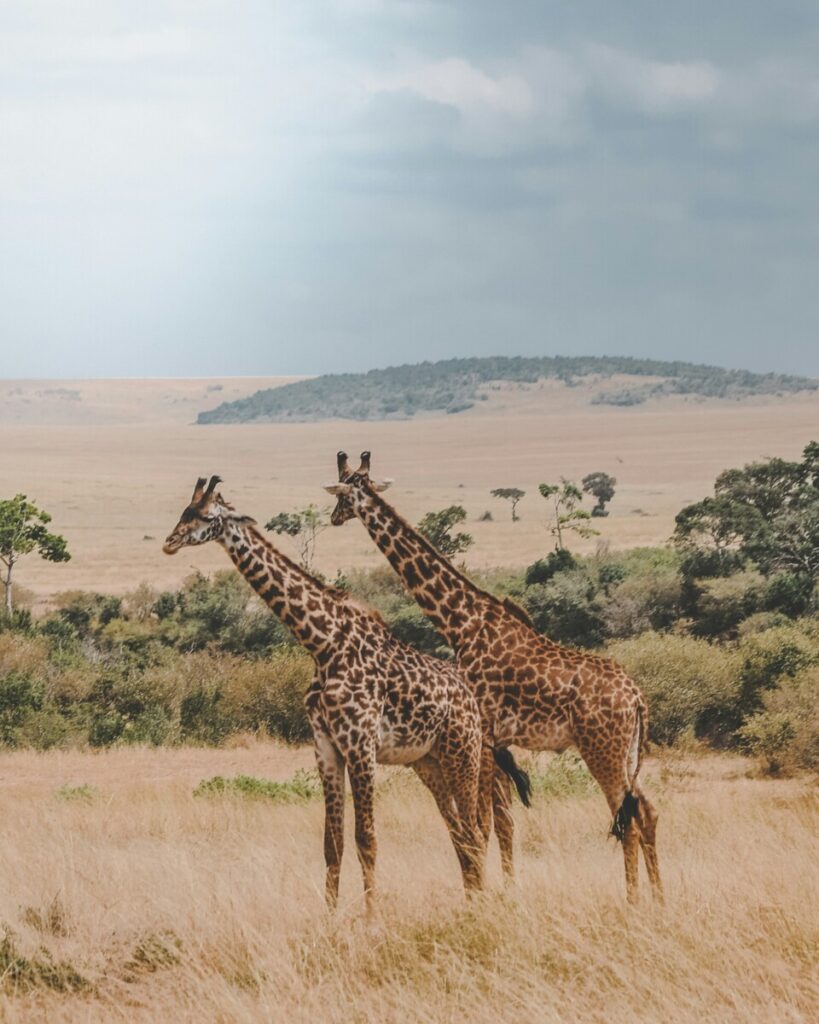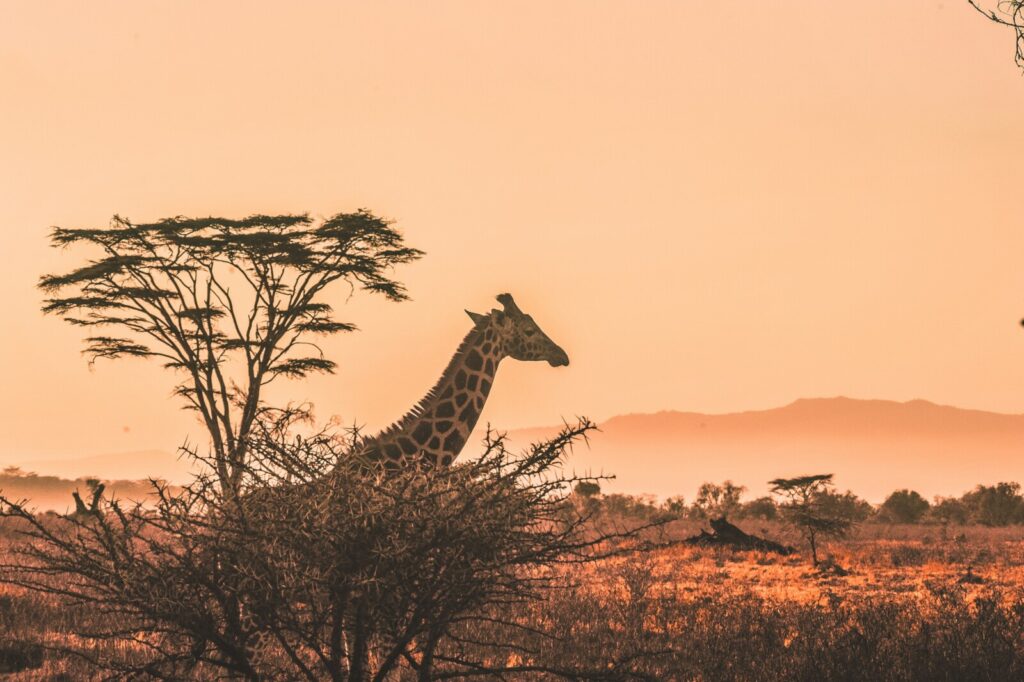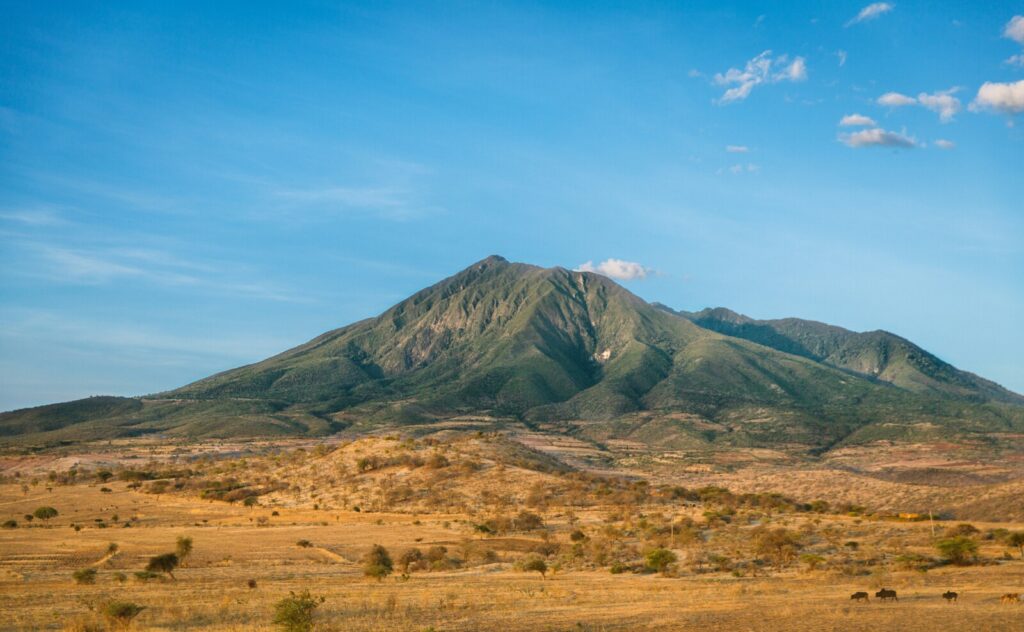Volunteering is an unforgettable experience. Not only because it means being part of projects that promote the development of communities with various needs, but also because it is an immersive cultural experience. It allows us to delve into another culture, discover its traditions, and enjoy its surroundings by visiting truly magical places.
Every year, many people choose one of our destinations in Africa: Kenya, Uganda, Tanzania…
In these countries, there are many activities you can do in your free time, but without a doubt, the most popular one is experiencing a Safari. And there’s no better place than the most renowned continent for this activity.
Today, we want to tell you about some of the most popular National Parks to go on a Safari—an experience that many people consider a must-do at least once in a lifetime.

- SERENGETI NATIONAL PARK (Tanzania)
As one of the world’s most emblematic and popular parks, this park spans 14,750 km² of savannah and is home to much wildlife. It also hosts one of the most incredible natural events, “The Great Migration.”
The Great Migration in Serengeti is one of nature’s most magnificent spectacles. Each year, around 1.5 million wildebeests, along with hundreds of thousands of zebras and gazelles, cross the park searching for fresh grazing. This phenomenon includes dangerous crossings at the Mara River, where crocodiles lie in wait for animals attempting to traverse. Predators like lions, cheetahs, and hyenas are also drawn to the migration.
The Serengeti is home to the “Big Five”: lion, leopard, elephant, buffalo, and rhinoceros, although rhinos are the rarest to spot. Additionally, you can observe large populations of cheetahs, giraffes, hippos, crocodiles, various antelope species, and a rich variety of birdlife.
The park comprises different ecosystems, from savannas to woodlands, and areas of rocky hills known as kopjes (rock formations), which provide shelter for predators and excellent observation points. The diversity of landscapes makes the park interesting not only for its wildlife but also for its scenic beauty.
The most popular way to explore the Serengeti is through vehicle safaris, where expert guides lead visitors to different zones to spot wildlife. There are also balloon rides for those who want to see the wildlife from the air at sunrise.
The best times to see large gatherings of animals vary: from December to March, the southern Serengeti is more popular, while from June to September, the river zones in the north are busier.
This UNESCO World Heritage site’s conservation is crucial for protecting biodiversity and preserving one of the world’s oldest grassland ecosystems.
- MASAI MARA NATIONAL PARK (Kenya)
Another of Africa’s and the world’s iconic parks, it stands out for its biodiversity, covering more than 1,500 km², and also plays a significant role in “The Great Migration” as it borders the Serengeti National Park.
The Great Migration leads all the animals mentioned earlier to cross the Mara River into Masai Mara, a spectacle that leaves all who witness it in awe.
This park is also home to the “Big Five” and large populations of cheetahs, hippos, crocodiles, and various antelope species. The reserve is particularly known for its large lion population, including the dark-maned lions, a symbol of the park. It’s also a great place for bird-watching, with more than 450 species, including birds of prey and ostriches.
Comprising open savannas with rolling hills, riverine forest areas, and the famous Mara River crossing the reserve, these diverse ecosystems allow for a rich variety of wildlife across different zones. The savanna formations of Masai Mara, with scattered acacia trees and expansive plains, have been featured in numerous documentaries and films.
The park is also popular for offering a cultural experience with the Maasai, a semi-nomadic indigenous community around the reserve that maintains its traditional culture and lifestyle. Visiting this park allows you to learn about their customs, dances, attire, and architecture. The symbiotic relationship between the reserve and the Maasai is essential for conservation in the area.
The most popular way to explore the reserve is with experienced guides driving through different park areas to maximize wildlife viewing opportunities. Balloon rides are also available.
July to October is the best time to see the Great Migration, while January and February, with dry weather, provide good animal sightings as they gather around water sources.
Masai Mara is one of Kenya’s most visited reserves and plays a crucial role in biodiversity conservation. Its protection is essential to ensure the continuity of the Great Migration and to preserve critical habitats for various species.
- AMBOSELI NATIONAL PARK (Kenya)
Located in Kenya, this park is especially popular for its incredible views of Mount Kilimanjaro, Africa’s highest mountain. The park borders Tanzania and spans about 392 km².
It is also famous for its large elephant herds and unique landscapes with swamps and vast plains. The image of elephants walking across the plains with Kilimanjaro in the background is one of Africa’s most iconic sights. Though Kilimanjaro is in Tanzania, its southern face offers spectacular views from Amboseli, particularly at sunrise and sunset when the weather is clearest.
Amboseli is known as one of the best places in Africa to see elephants up close. The elephants here have especially large tusks, and you can watch them interact and move in herds. Several studies and conservation initiatives have been conducted in Amboseli, contributing to the protection of this emblematic species.
Despite its semi-desert environment, it has swamps fed by Kilimanjaro’s meltwater, creating an oasis in the dry savanna. These swamps attract a diverse range of wildlife and birds, including buffaloes, hippos, and various waterfowl species like herons and pelicans.
In addition to elephants, Amboseli is home to many mammals, including lions, cheetahs, giraffes, zebras, hyenas, and buffaloes. The open plains make it easy to spot animals and offer excellent opportunities for predator-watching. It is also a great place for bird-watching, with more than 400 species recorded, from waterbirds to raptors.
Since Amboseli is also located in Maasai territory, you can visit villages and learn about their culture.
The best time for wildlife viewing is during the dry season from June to October, when animals congregate around water sources, while the landscape turns greener from November to May, making it a good time for bird-watchers.
Amboseli is a UNESCO Biosphere Reserve, and its conservation is crucial for the protection of its unique ecosystems and the wildlife it harbors, particularly its elephants.

- TARANGIRE NATIONAL PARK (Tanzania)
Located in Tanzania, this park is known for its impressive concentration of elephants, baobab-studded landscapes, and authentic, quieter safari experience compared to other parks. Covering over 2,800 km², it is Tanzania’s sixth-largest park and a very popular destination.
The park is named after the Tarangire River, a vital water source running through it, which becomes a magnet for animals, especially in the dry season. During dry months, when water is scarce elsewhere, large herds of animals migrate toward the Tarangire River, creating an exceptional safari experience with high concentrations of wildlife around the river.
Tarangire is especially famous for its massive elephant populations. It’s common to see herds of up to 300 elephants gathering around water sources. This park is one of the best places in Tanzania to watch elephants closely and observe their social behaviors in their natural habitat.
One of Tarangire’s most distinctive features is the abundance of baobabs that dominate the landscape. These ancient trees are not only impressive but also play an ecological role by providing shelter and food for various species.
In addition to elephants, it hosts a wide variety of species, including lions, leopards, giraffes, buffaloes, hyenas, cheetahs, and various antelope species like kudu, oryx, and gerenuk. The park is also home to the elusive African wild dog and some uncommon species in other parts of Tanzania, along with a wide variety of birds.
Although Tarangire is not part of the famous Serengeti migration, it experiences its seasonal migration. During the dry season (June to October), thousands of animals migrate into the park from neighboring areas, enhancing wildlife viewing opportunities.
In Tarangire, you can also go on night safaris—a unique experience.
Tarangire is an essential park for conservation in Tanzania, not only for its elephant population but also for its role in preserving less common species, like the lesser kudu and African wild dogs.
- TSAVO NATIONAL PARK (Kenya)
It is one of the largest parks in the world, covering 22,000 km². It is divided into Tsavo East and Tsavo West, and its impressive landscapes, rich biodiversity, and variety of habitats make it an ideal destination.
- Tsavo East is known for its vast open plains, the Galana River, and its distinctive red-colored elephants, which obtain their unique tone by wallowing in the park’s red soil.
- Tsavo West is characterized by volcanic hills, natural springs like the Mzima Springs, and denser vegetation, which gives the safari routes a mysterious atmosphere and makes it an ideal place to see wildlife in a wild setting.
The red elephants are iconic, and the park is home to one of Kenya’s largest elephant populations. It is also known for the maneless lions, popularized by the story of the “Man-Eating Lions of Tsavo.” During the construction of the Kenya railway in the 19th century, two maneless male lions caused panic by attacking workers, and their story became legendary. Today, Tsavo’s lions are a major attraction, and although attacks on humans are rare, these lions maintain their reputation as skilled and strong hunters.
Besides elephants and lions, Tsavo is home to buffalo, giraffes, zebras, hippos, black rhinos, leopards, and a large variety of antelope and bird species. Tsavo West, with its denser vegetation, is ideal for spotting rhinos at the Ngulia Rhino Sanctuary, offering an opportunity to see these animals in their protected habitat.
Tsavo West has numerous volcanic hills and rock formations, such as the Chaimu Crater and Shetani Lava Flows, which are the result of relatively recent eruptions and add a unique landscape to the park.
In addition to 4×4 safaris, visitors can enjoy underwater observation at Mzima Springs thanks to a submerged viewing chamber, as well as rock climbing on the volcanic hills and, of course, bird watching.
From June to October is the best time to visit, as wildlife concentrates around water sources and visibility is optimal. This period makes it easier to spot animals in both Tsavo East and Tsavo West.
Tsavo plays a crucial role in the conservation of Kenya’s wildlife, serving as an important sanctuary for elephants, rhinos, and a wide variety of species.
- QUEEN ELIZABETH NATIONAL PARK (Uganda)
One of Uganda’s most popular tourist destinations, it is known for its diverse landscapes and wildlife. Located in southwestern Uganda near the city of Kasese, the park covers over 1,900 km² and stretches along the edges of Lake Edward and the Kazinga Channel.
The park’s wildlife includes more than 95 species of mammals and 600 species of birds. Among the most popular animals are lions, elephants, hippos, buffalo, and various species of primates, including chimpanzees.
The park is known for its stunning landscapes, which include grassy plains, forests, volcanic craters, and the famous Kazinga Channel, which connects Lake Edward and Lake George. This channel is ideal for boat rides, offering excellent opportunities to observe hippos, crocodiles, and a variety of water birds.
Visitors can enjoy vehicle safaris, boat rides, guided walks, and bird-watching excursions. The park is also famous for its night safaris, which allow wildlife viewing in a different setting.
You can also have a cultural experience by immersing yourself in communities such as the Bakonzo and the Basangora, learning about their traditions and ways of life.
Queen Elizabeth National Park is part of a broader conservation effort that includes protecting Uganda’s ecosystems and wildlife. Efforts to preserve rhinos, which once lived in the region, remain a priority.

There are many other popular parks for an unforgettable safari experience, such as Bwindi Impenetrable National Park, Ruaha National Park, Nyerere National Park, and Lake Nakuru National Park… and we are convinced that each of them offers an adrenaline-filled adventure.
Africa awaits you.




